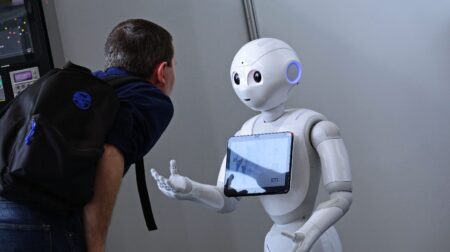A team of scientists from the University of Cambridge and University College London has developed a new type of low-cost, highly durable electronic ‘skin’ that enables robots to sense and respond to their environment in a way that more closely resembles human touch.
The flexible, conductive material, described as a type of ‘robotic glove’ can be moulded into complex shapes and detects a variety of physical stimuli such as pressure, temperature, and damage.
READ MORE: £86bn boost for science and technology aims to drive UK economic growth
Unlike many existing robotic sensors that rely on discrete components for specific types of feedback, the new skin functions as a single, multi-modal sensor, with the entire surface capable of collecting and processing sensory information.
Composed of a stretchable and electrically conductive animal gelatine hydrogel, the material was cast into the shape of a human hand.
Using 32 electrodes placed at the wrist, researchers were able to extract more than 1.7 million pieces of sensory data from across the hand, owing to the more than 860,000 microscopic pathways embedded in the material.
In testing, the artificial skin demonstrated the ability to detect a variety of interactions, including finger taps, exposure to hot and cold temperatures, and physical damage such as cuts or stabs.
The team also utilised machine learning algorithms to train the system to distinguish between different types of touch more accurately, enabling more effective and nuanced robotic responses.
While the material is not yet as sensitive as human skin, the researchers believe it marks a significant step forward in robotic sensing.
Potential future applications include use in humanoid robots and advanced prosthetics, where a sense of touch is essential, as well as in fields such as automotive engineering and disaster recovery.
Electronic skins typically convert physical inputs into electronic signals using multiple types of sensors, which can complicate design and reduce durability. In contrast, the Cambridge-UCL team’s single-sensor, multi-modal approach offers improved robustness and simpler manufacturing.
The research was supported by the Samsung Global Research Outreach Program, the Royal Society, and the Engineering and Physical Sciences Research Council (EPSRC), part of UK Research and Innovation (UKRI).
 Achievements and innovations in warehouse automation across retail and e-commerce, healthcare and pharmaceuticals, food and beverage, automotive, transport and logistics, and more will be celebrated at the third annual Robotics & Automation Awards on 29 October 2025 at De Vere Grand Connaught Rooms in London. Visit www.roboticsandautomationawards.co.uk to learn more about this unmissable event for the UK’s robotics and automation sectors!
Achievements and innovations in warehouse automation across retail and e-commerce, healthcare and pharmaceuticals, food and beverage, automotive, transport and logistics, and more will be celebrated at the third annual Robotics & Automation Awards on 29 October 2025 at De Vere Grand Connaught Rooms in London. Visit www.roboticsandautomationawards.co.uk to learn more about this unmissable event for the UK’s robotics and automation sectors!








